Step by Step Instructions (Composite Calibration)
Purpose: Complete IMRT analysis with calibration, dose mapping and plan comparison.
This example is based on balanced composite calibration using secondary calibration data scanned separately and configured in an extra task (Task I).
Secondary calibration data are balanced with the properties of the primary data (Task II) referenced by (few) calibration data (e.g. two calibration strips).
Note: This protocol variation was implemented for downward data compatibility.
The scan with the secondary calibration data introduces scan to scan variation as additional dose error source.
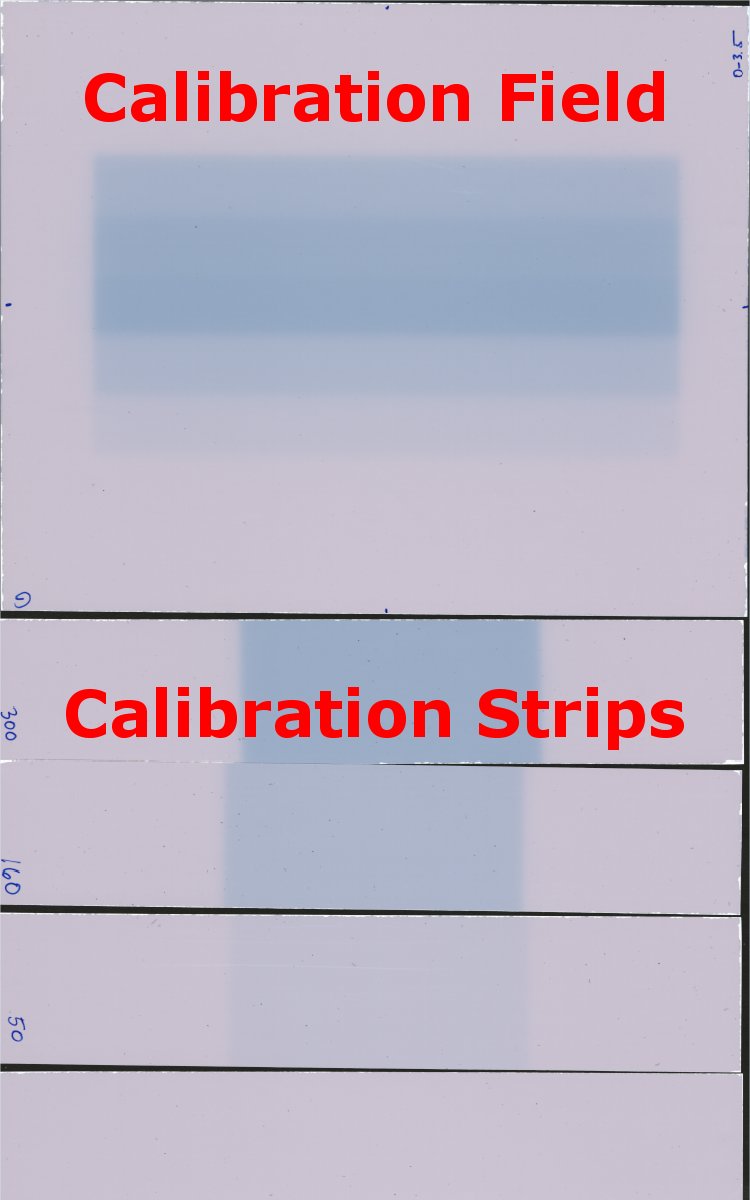
|
Protocol involves two images:
Scan with secondary calibration data must include
-
Calibration field (calibration plan data are required)
or
-
Calibration strips exposed to flat field (flat field dose values at isocenter are required).
|

|
Primary data scan must include
-
Treatment field (treatment plan data are required).
-
Calibration strips or calibration field to balance data of the seconday scan with scaling of primary scan.
Minimum requirement is one exposued strip and one unexposed strip.
|
Alternatively same treatment field example is available with
Data: Installation folder '.\Data\Example Prostate 250 cGy'.
|
1. Add Task (secondary calibration data)
Add new task 'IMRT analysis (All in 1)' to the document.
Right click
 icon ('Landscape scan') and load bitmap 'Scan_Strips Wedge 350 cGy.tif'.
icon ('Landscape scan') and load bitmap 'Scan_Strips Wedge 350 cGy.tif'.

|
|
2. Calibration area (secondary calibration)
Select frame tool
 and draw frame around the step wedge calibration area as shown below.
and draw frame around the step wedge calibration area as shown below.
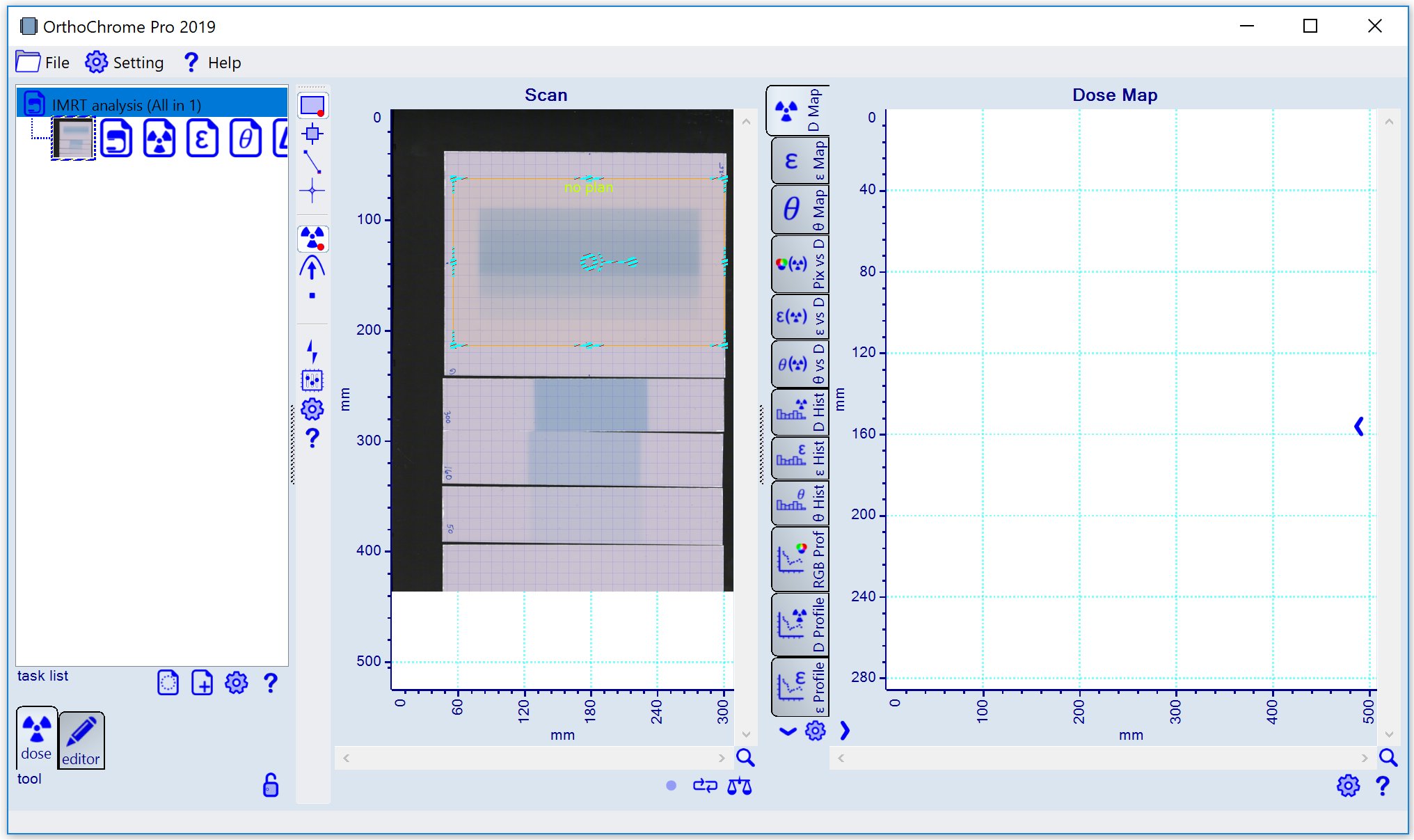
|
|
3. Assign calibration plan (secondary calibration)
Right click inside the drawn frame and select in the context menu 'Assign calibration plan'
 and load the plan data 'Prostate 250 cGy Step Calibration 0-3.5 Gy Dose Plane.dcm' (use the filter 'DICOM - dcm (single image)').
Note: The plan image needs to be rotated by 180° as shown below. Any quadrant adjustment (rotation, flipping), dose range scaling or cropping can be carried out in the 'Bitmap Reader' panel.
and load the plan data 'Prostate 250 cGy Step Calibration 0-3.5 Gy Dose Plane.dcm' (use the filter 'DICOM - dcm (single image)').
Note: The plan image needs to be rotated by 180° as shown below. Any quadrant adjustment (rotation, flipping), dose range scaling or cropping can be carried out in the 'Bitmap Reader' panel.
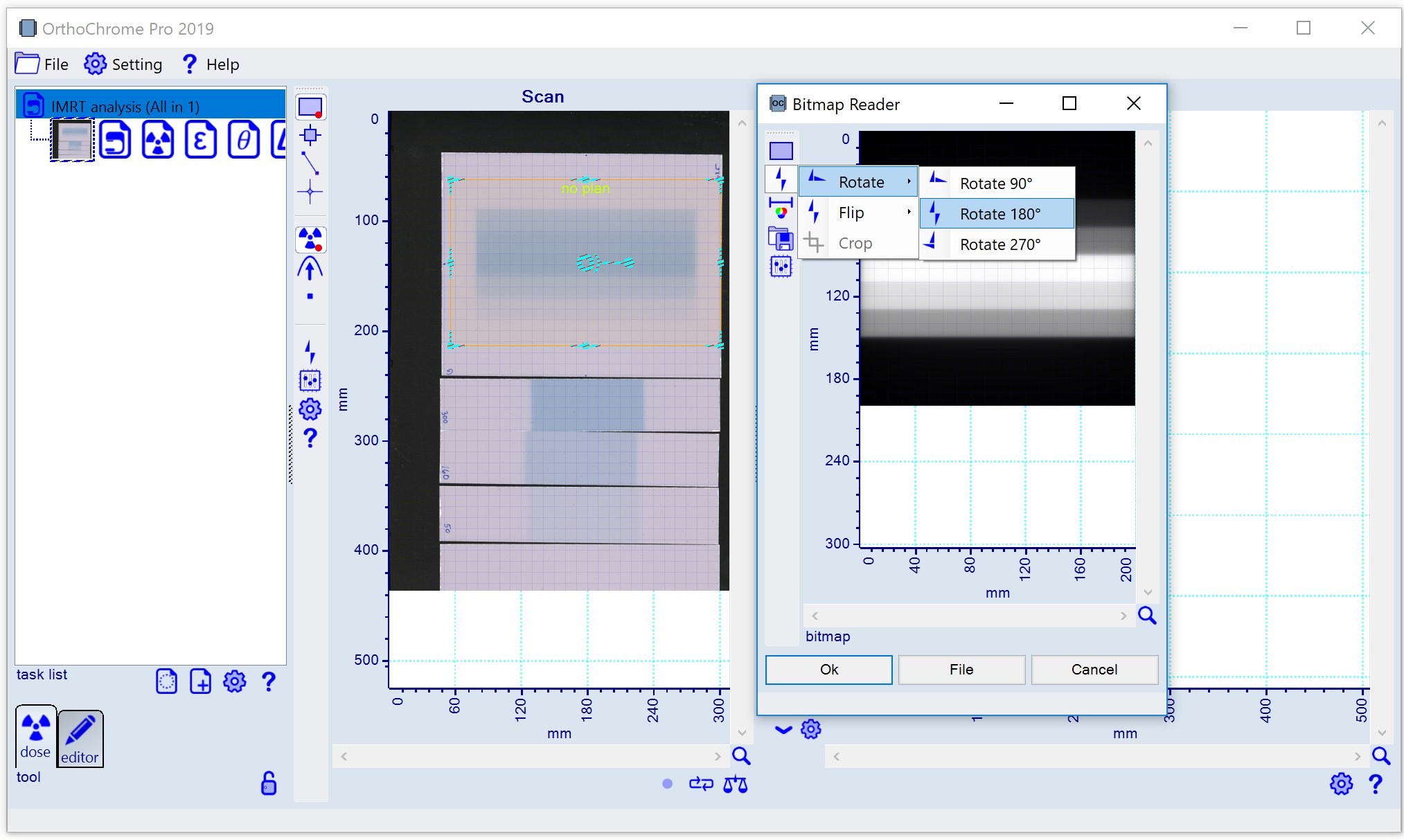
|
|
4. Calibration and Dose Map Generation (secondary calibration)
After the calibration plan is assigned, the calibration and dose map generation starts automatically (enabled by default) indicated by LED symbol
 underneath the center image. One can recalibrate at any time using the
underneath the center image. One can recalibrate at any time using the
 button.
To profile the calibration data vs calibration plan assign a predefine paths by right clicking inside the calibration frame as shown below.
button.
To profile the calibration data vs calibration plan assign a predefine paths by right clicking inside the calibration frame as shown below.
 Select the 'Dose Profile' tab
Select the 'Dose Profile' tab
 of the chart mosaic to get the display as shown below indicating that the registration of the calibration plan is not perfect yet.
of the chart mosaic to get the display as shown below indicating that the registration of the calibration plan is not perfect yet.

|
|
5. Optimization of calibration plan registration
Toggle from calibration mode
 to optimization
to optimization
 (selected icon carries red mark). The mosaic chart changes as shown below including now numerical fields for registration and comparison data.
(selected icon carries red mark). The mosaic chart changes as shown below including now numerical fields for registration and comparison data.
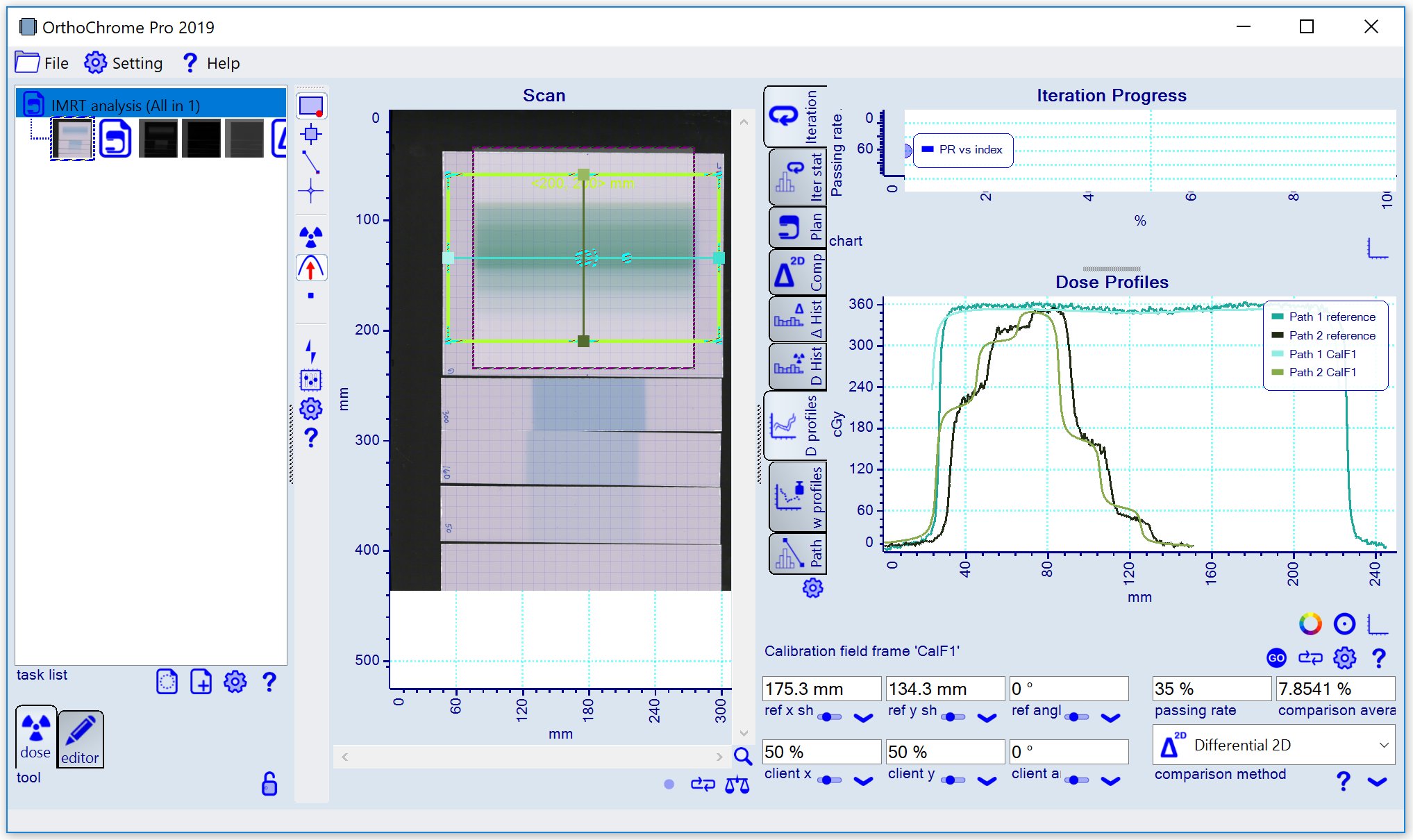
The 'comparison method' can be modified, e.g. to 'Gamma 2D' (use
 to modify comparison parameters).
To start the optimization of the calibration plan registration press the
to modify comparison parameters).
To start the optimization of the calibration plan registration press the
 button - below OC Pro panel with active optimization.
Note: The path locations can be modified during the optimization - activate path tool
button - below OC Pro panel with active optimization.
Note: The path locations can be modified during the optimization - activate path tool
 than click the path to be changed.
than click the path to be changed.
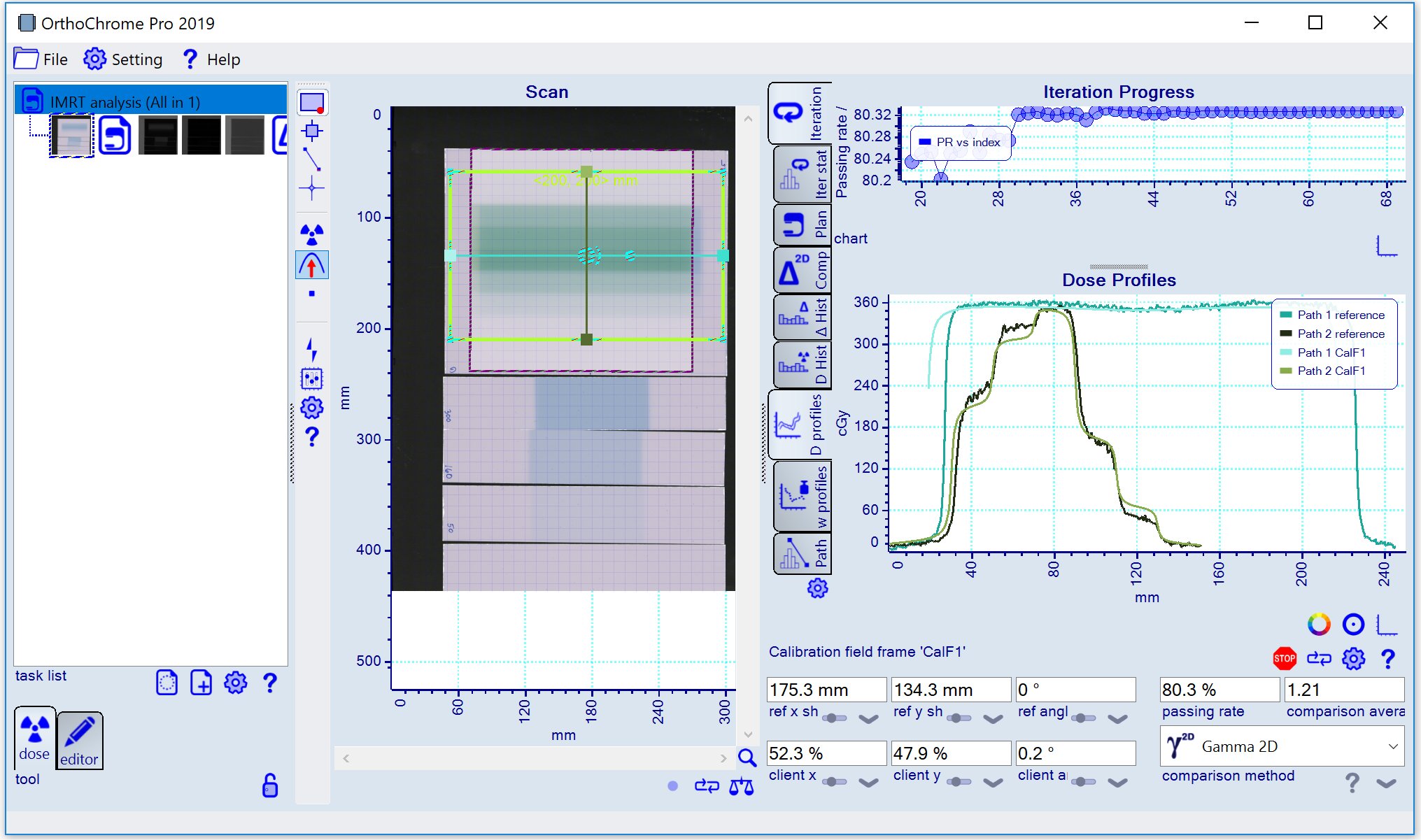
Stop the registration optimization when calibration data and calibration plan agree well enough by pressing the
 button.
Important: After calibration registration is optimized, recalibrate and update dose data by pressing the
button.
Important: After calibration registration is optimized, recalibrate and update dose data by pressing the
 update button. Otherwise the improved calibration registration will Not be reflected by the calibration and dose map data!
update button. Otherwise the improved calibration registration will Not be reflected by the calibration and dose map data!
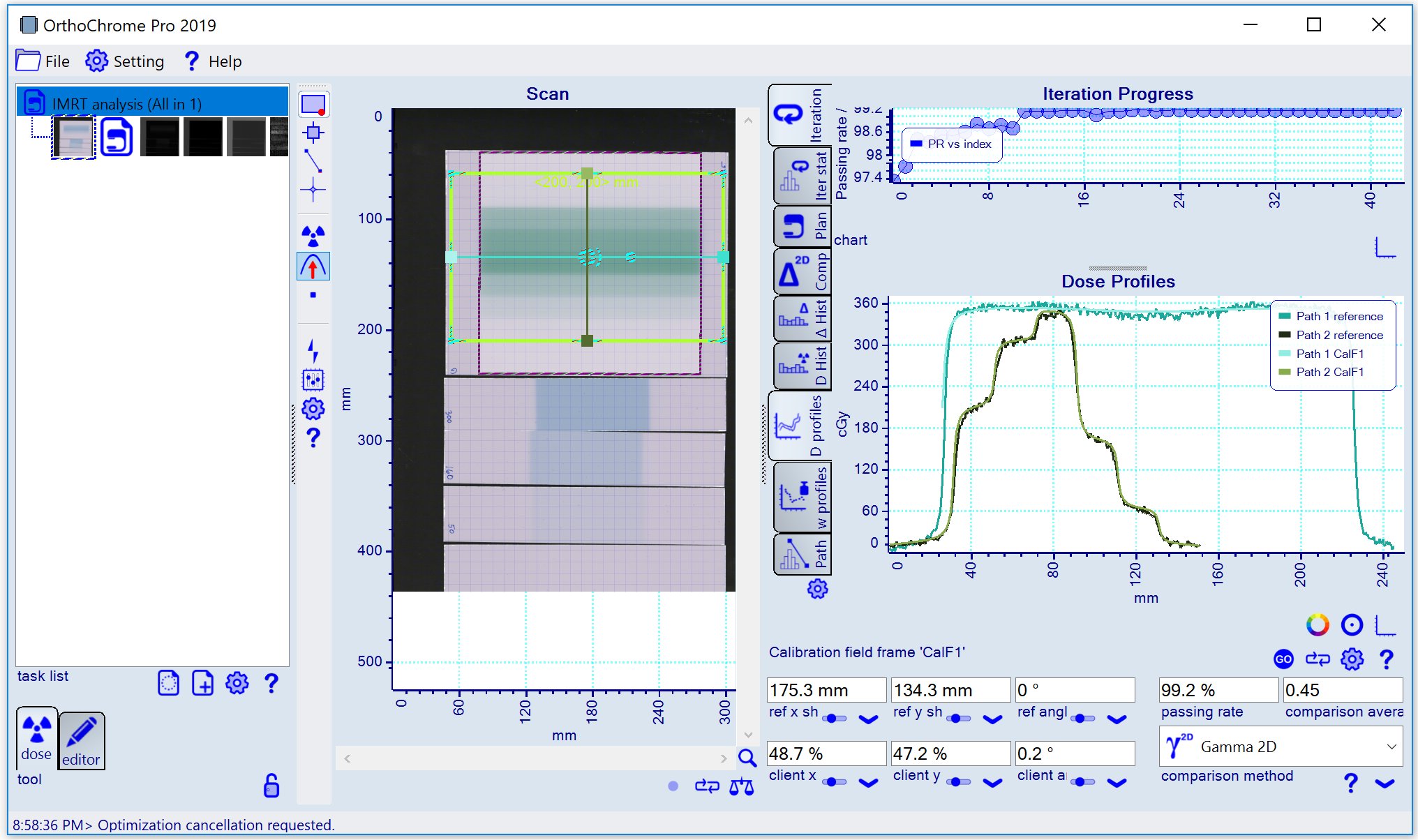
Above the improved plan vs dose match when recalibrating after auto-registration.
|
|
6. Add Task (primary)
Add new task 'IMRT analysis (All in 1)' to the document.
Right click
 icon ('Landscape scan') and load bitmap 'Scan_Prostate 250 cGy Strips.tif'.
icon ('Landscape scan') and load bitmap 'Scan_Prostate 250 cGy Strips.tif'.
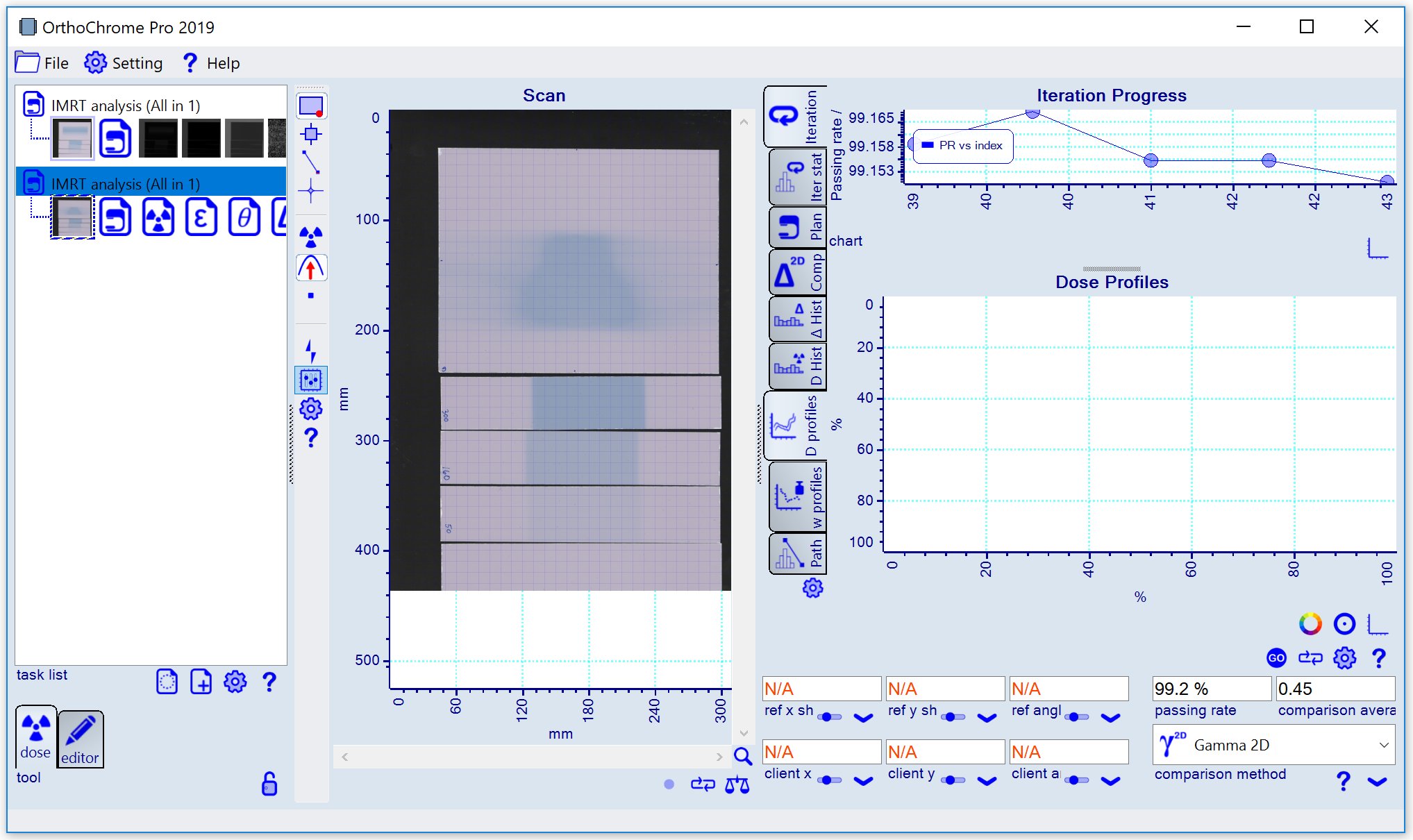
|
|
7. Calibration areas (primary)
Select frame tool
 and choose 'calibration strip' as frame type as shon below.
and choose 'calibration strip' as frame type as shon below.
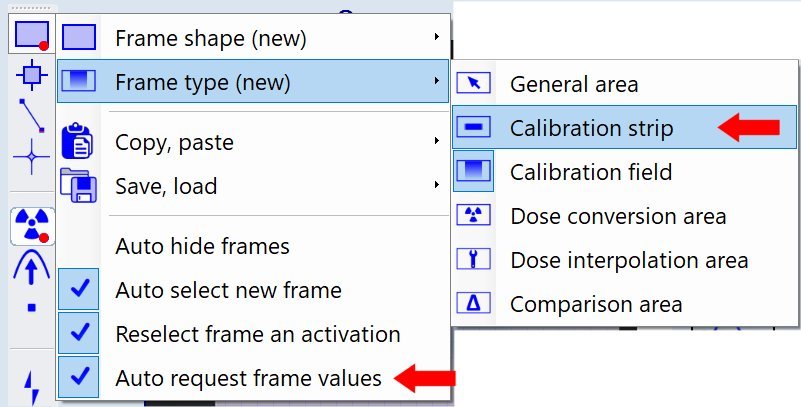 and draw frame for film strip to marke the calibration area. When the frame is selected a dialog panel to input the calibration dose value as shown below.
Note: The input of each dose value has to be fishshed by pressing the 'Enter' key.
and draw frame for film strip to marke the calibration area. When the frame is selected a dialog panel to input the calibration dose value as shown below.
Note: The input of each dose value has to be fishshed by pressing the 'Enter' key.
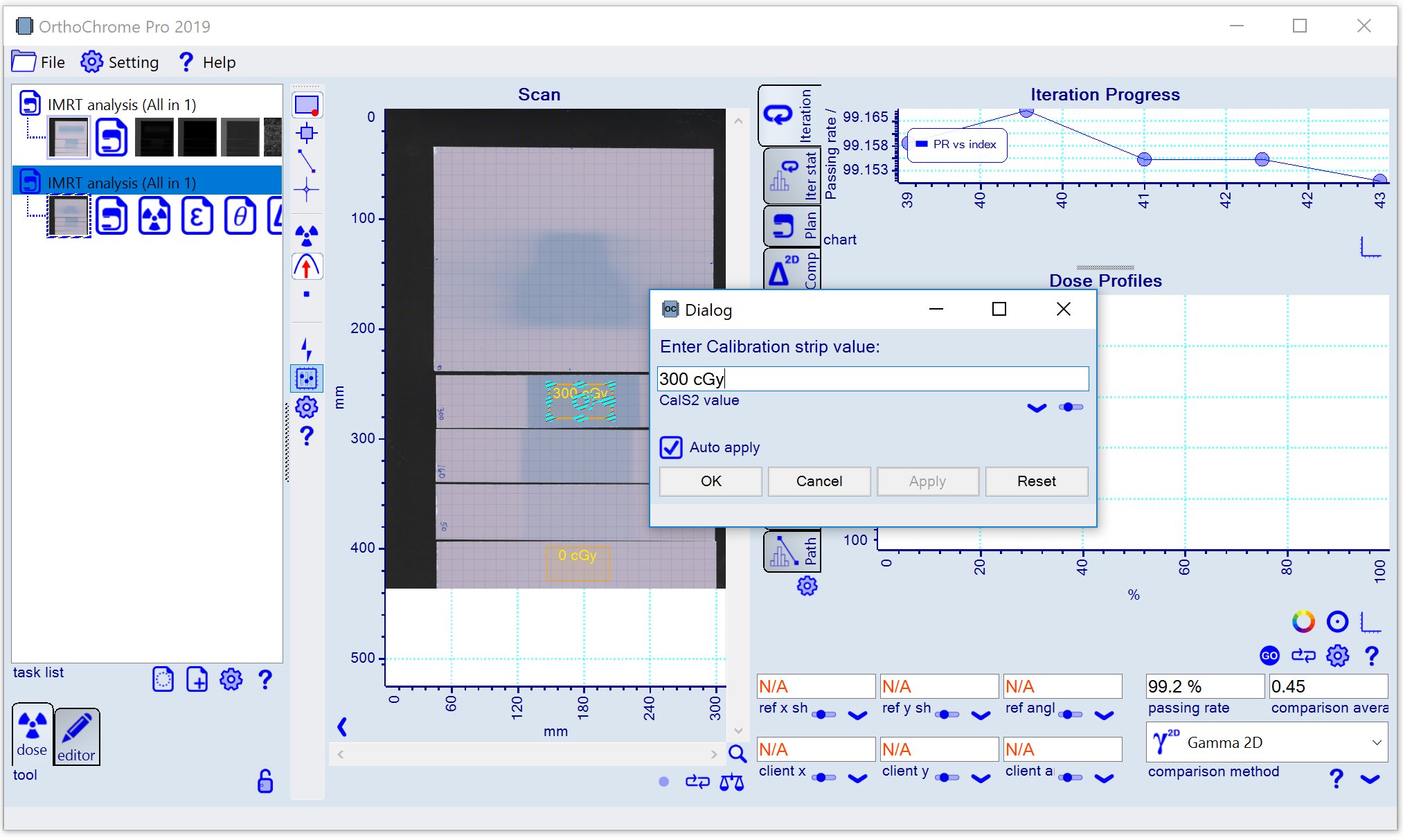
Assign a frame for each calibration strip.
Tip: Ctrl-key+Click places a copy of the currently selected frame with center at mouse click position.
For this example it is sufficient to assign only the frames for the 0 Gy and the 300 Gy calibration strips.
When both frames are assigned the OC Pro screen should look similar as shown below.
Each frame must carry the assigned calibration dose value - right click frame to change the calibration dose..
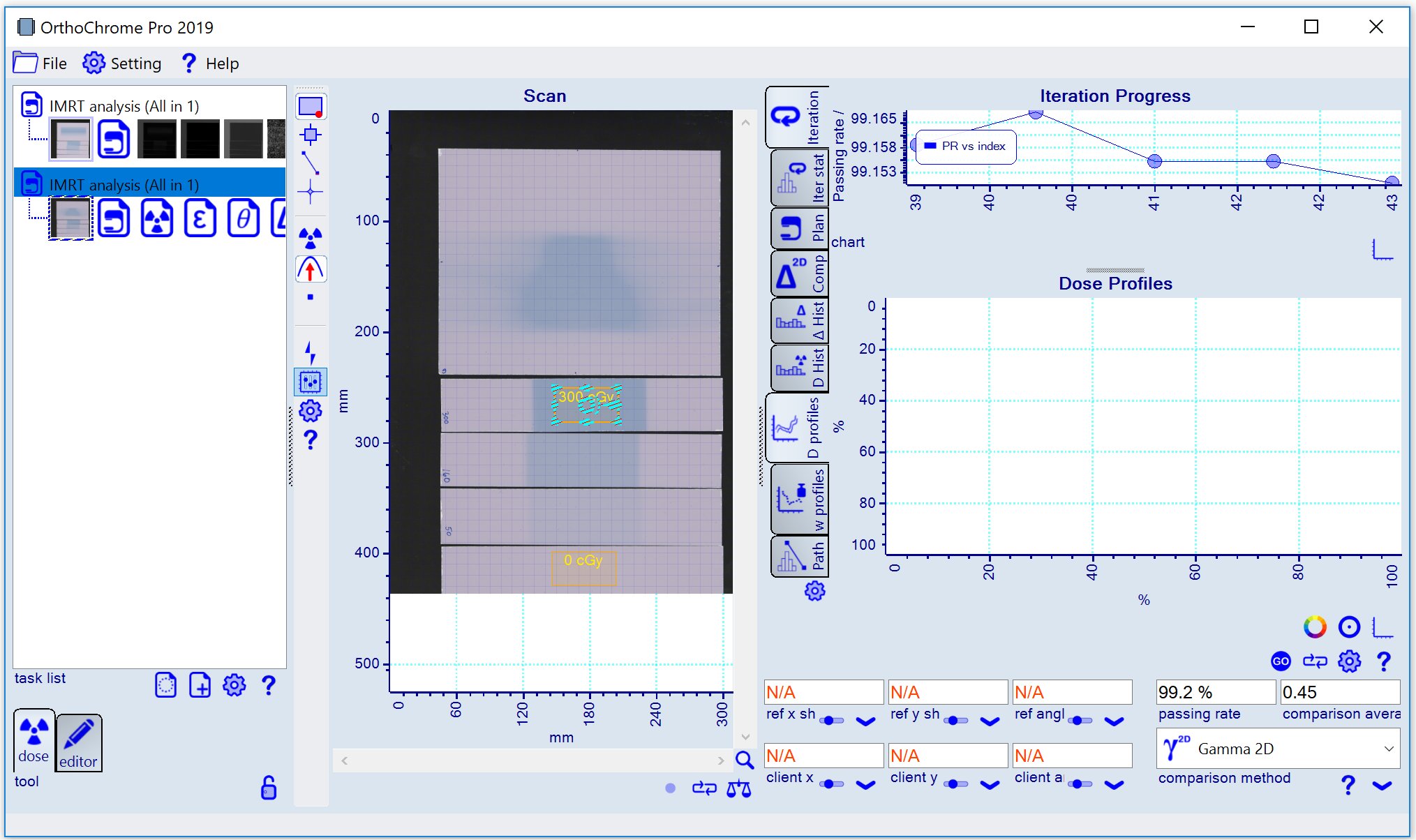
|
|
8. Calibration and Dose Map Generation
Toggle from optimization mode
 to calibration
to calibration
 (selected icon carries red mark).
Assign as 'Calibration quality' the 'Balanced Composite' option using the calibration task (only task available to select) as shown below.
(selected icon carries red mark).
Assign as 'Calibration quality' the 'Balanced Composite' option using the calibration task (only task available to select) as shown below.
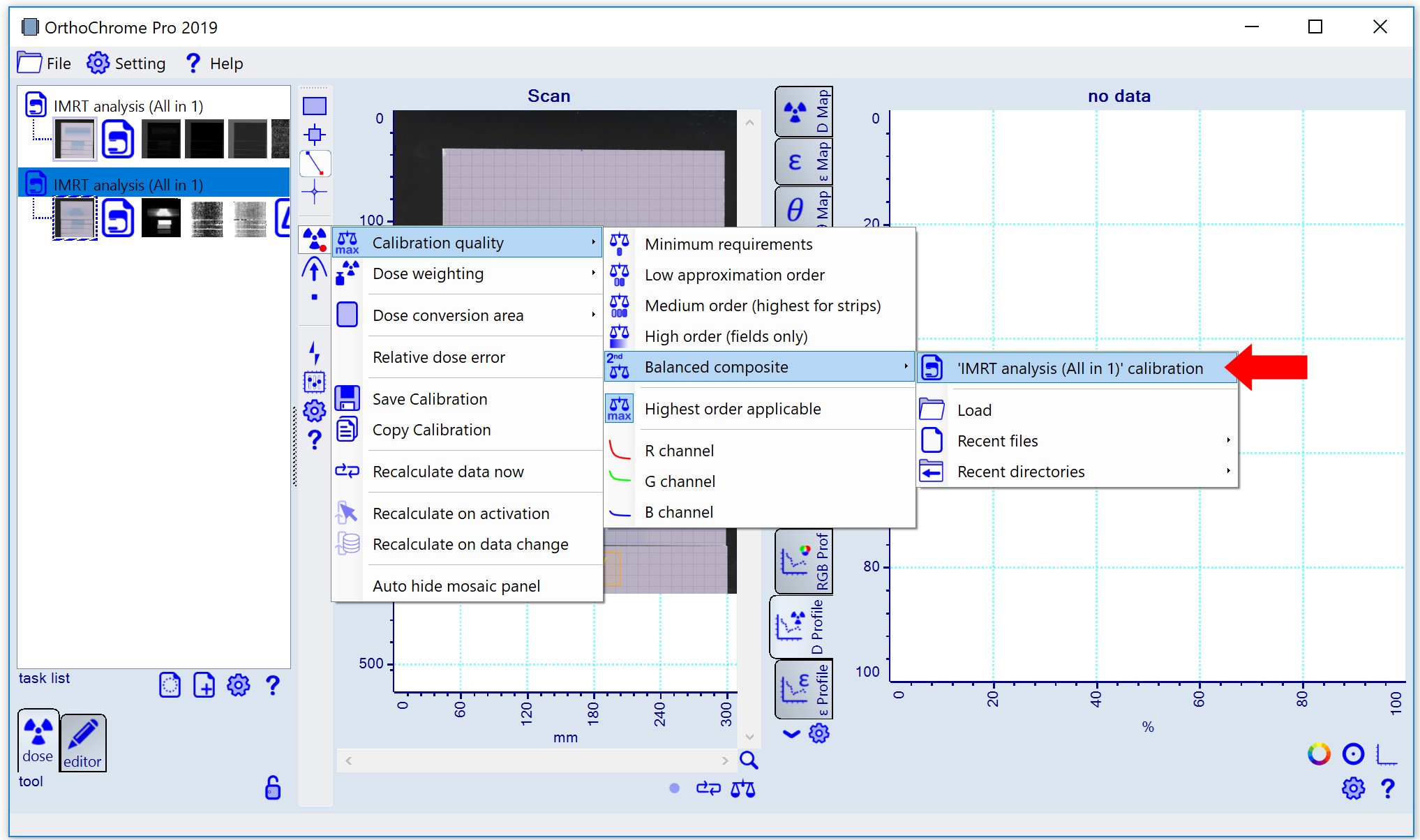
After the 'balanced composite' calibration is assigned, the calibration and dose map generation starts - the running process is indicated by red LED symbol
 underneath the center image. One can recalibrate at any time using the
underneath the center image. One can recalibrate at any time using the
 button.
To profile the calibration data assign a paths for each calibration frame as shown below.
Select the 'Dose Profile' tab
button.
To profile the calibration data assign a paths for each calibration frame as shown below.
Select the 'Dose Profile' tab
 of the chart mosaic to get the display as shown below indicating that the registration of the calibration plan is not perfect yet.
of the chart mosaic to get the display as shown below indicating that the registration of the calibration plan is not perfect yet.
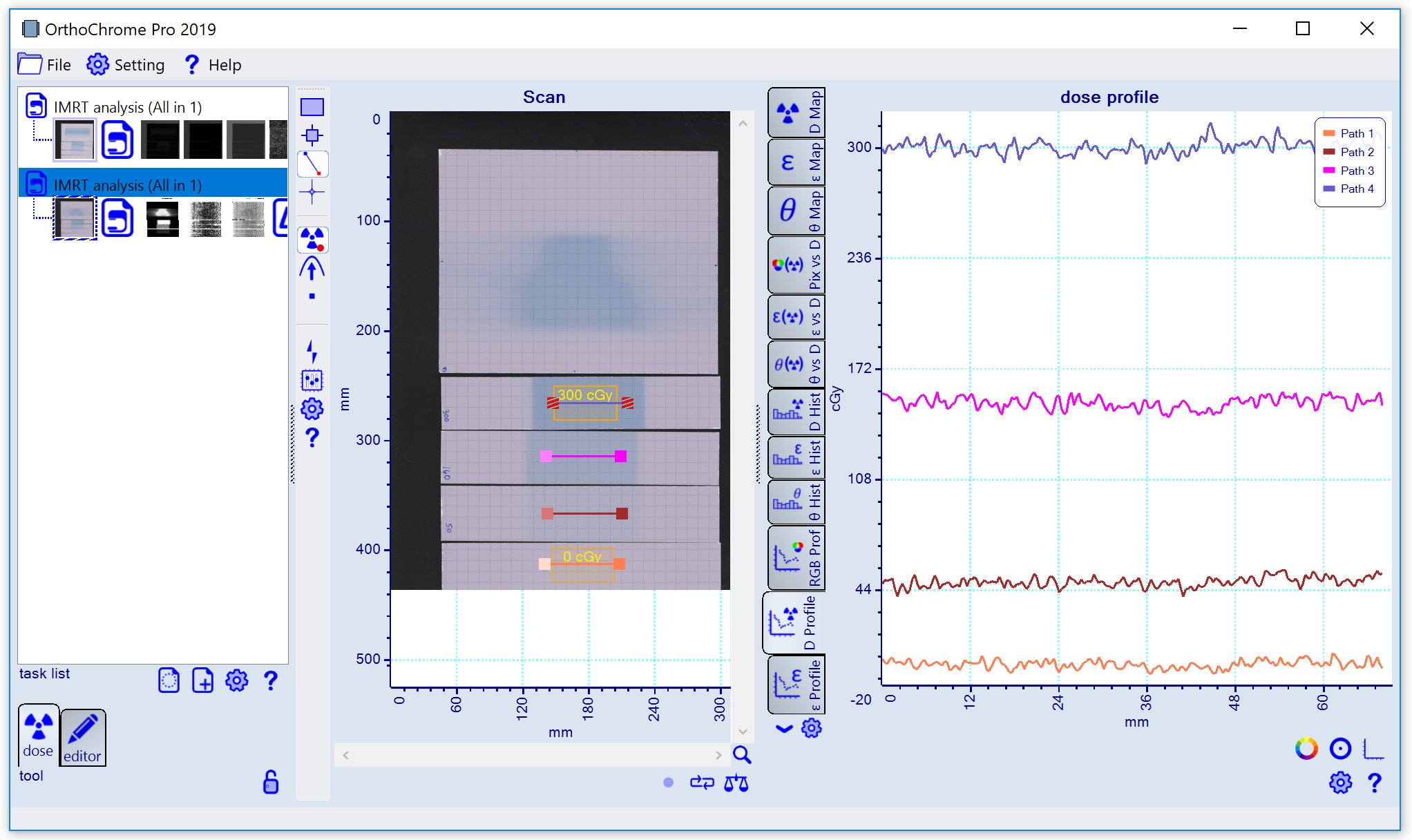
To delete the profile paths, click the profile tool icon and select 'Delete all paths'.
|
|
9. Comparison area and treatment plan assignment
Toggle from calibration mode
 to optimization
to optimization
 (selected icon carries red mark). Select frame tool
(selected icon carries red mark). Select frame tool
 and draw frame around the treatment field area as shown below.
and draw frame around the treatment field area as shown below.

Change the frame type to 'Comparison area', right click inside the frame and select the type as shown below.
 After the frame type is changed, a 'Load file' panel will pop up automatically to load the treatment plan data -
select the file 'Prostate 250 cGy Dose Plane.dcm' (use the filter 'DICOM - dcm (single image)').
The treatment plan can be changed any time by right clicking inside the comparison frame and using 'Assign treatment plan'.
Note: The treatment plan image needs to be rotated by 180° using the 'Bitmap Reader' as shown below.
After the frame type is changed, a 'Load file' panel will pop up automatically to load the treatment plan data -
select the file 'Prostate 250 cGy Dose Plane.dcm' (use the filter 'DICOM - dcm (single image)').
The treatment plan can be changed any time by right clicking inside the comparison frame and using 'Assign treatment plan'.
Note: The treatment plan image needs to be rotated by 180° using the 'Bitmap Reader' as shown below.
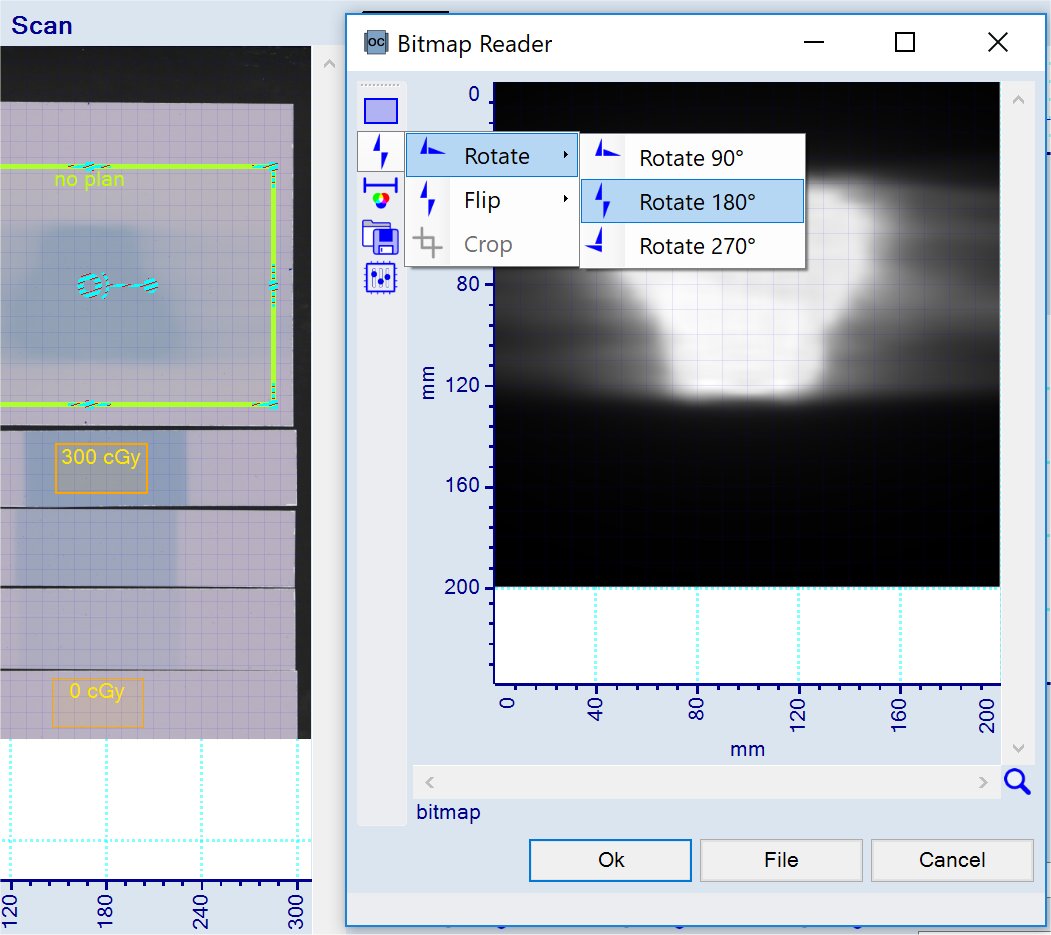 Assign path pattern to comparison frame to profile dose vs plan data, use context menu as shown below.
Assign path pattern to comparison frame to profile dose vs plan data, use context menu as shown below.
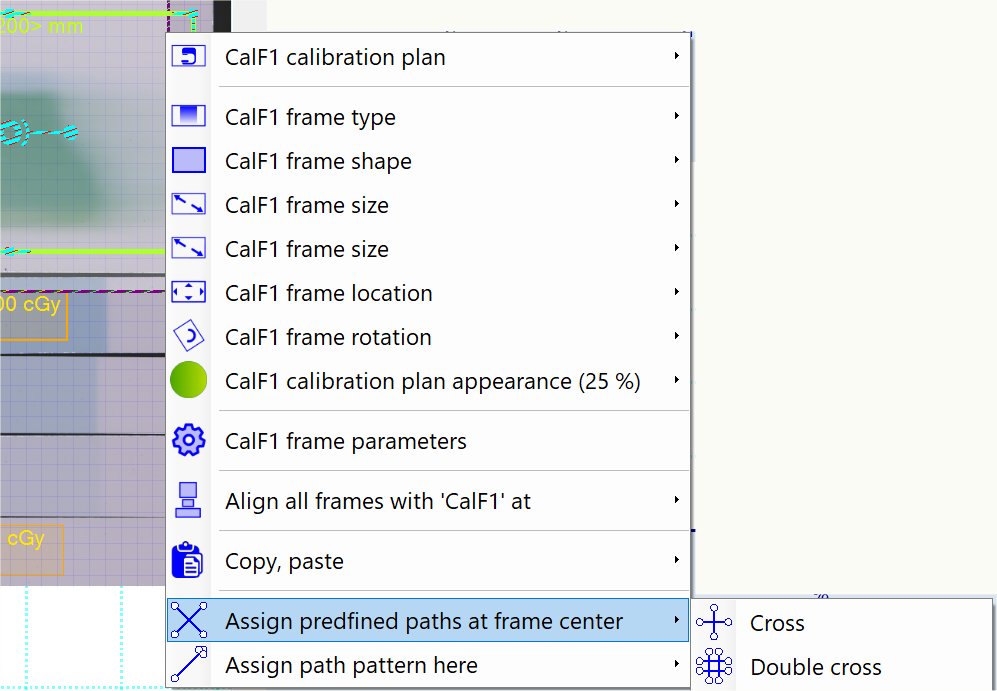 When the paths are assigned, the profiles dose vs treatment plan will look similar as shown below - since the plan registration is Not optimized yet,
there is a noticable profiles offset visible and the passing rate is still low.
When the paths are assigned, the profiles dose vs treatment plan will look similar as shown below - since the plan registration is Not optimized yet,
there is a noticable profiles offset visible and the passing rate is still low.
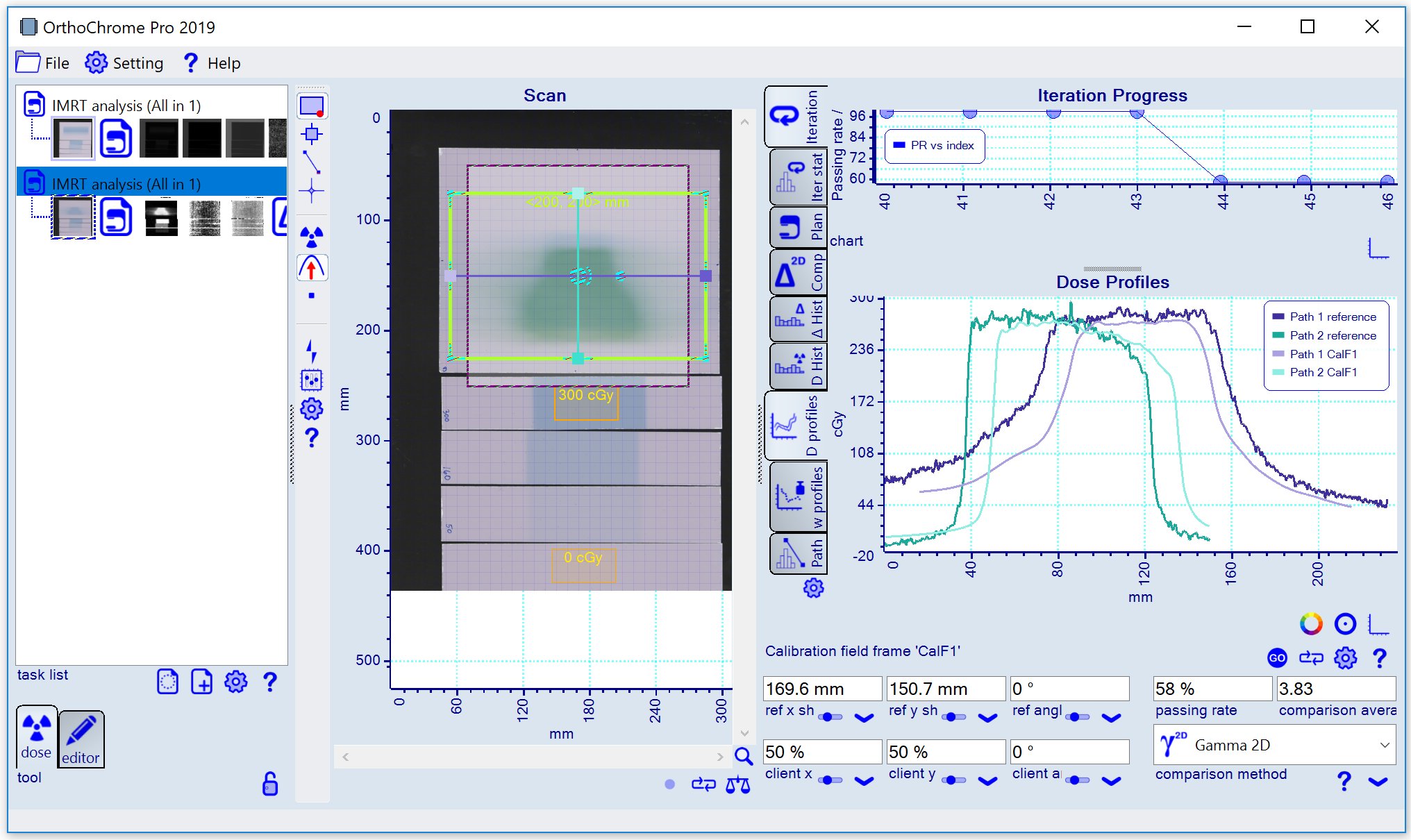
To update the comparison data in the mosaic chart, press update button
 next to the GO button.
next to the GO button.
|
|
7. Optimization of treatment plan registration
To start the optimization of the treatment plan registration press the
 button - below OC Pro panel optimizing plan registration.
button - below OC Pro panel optimizing plan registration.
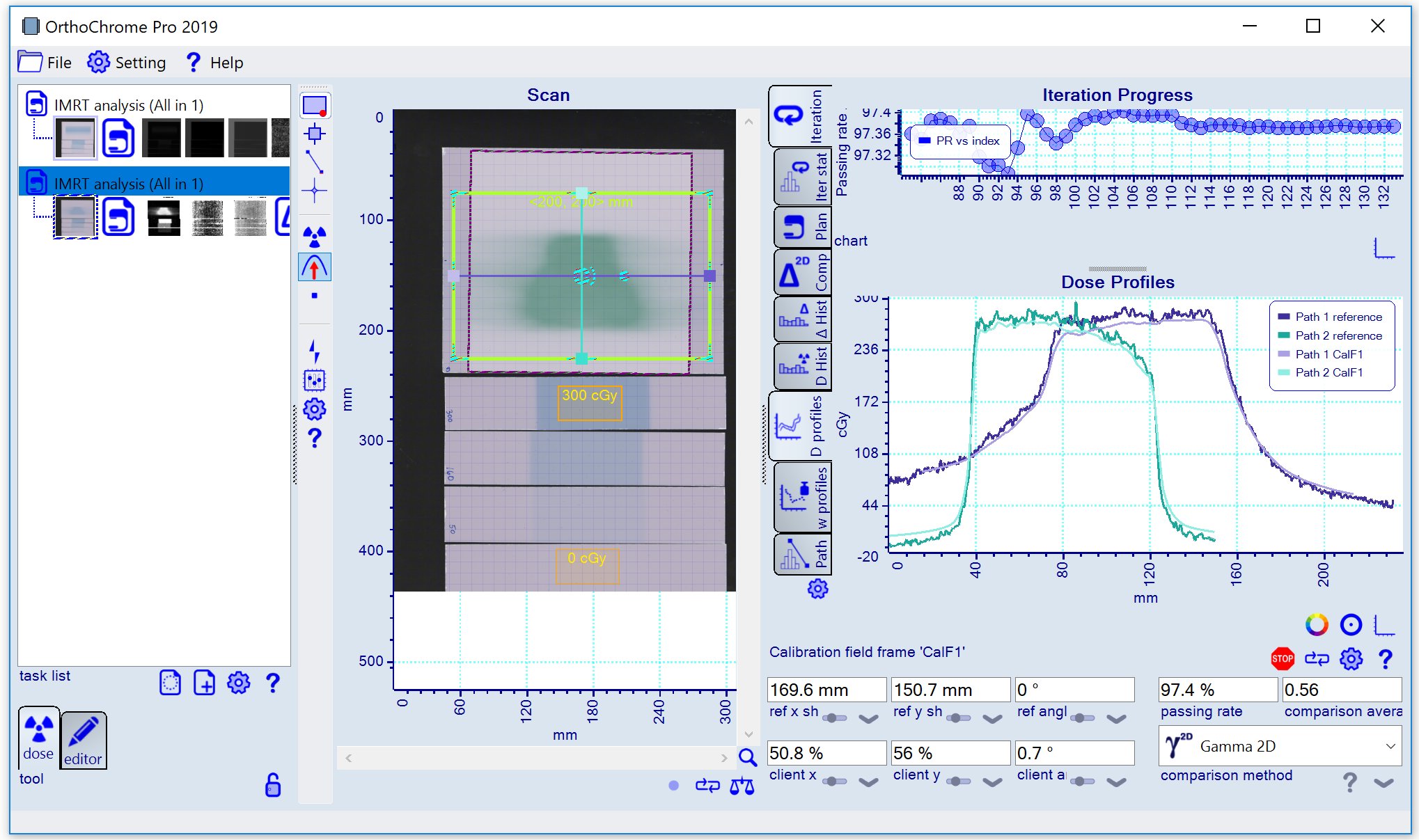
Stop the registration optimization when calibration data and treatment plan agree well enough by pressing the
 button. This completes the IMRT analysis process.
button. This completes the IMRT analysis process.
|
-- end of document --





 Add task primary
Add task primary

 icon ('Landscape scan') and load bitmap 'Scan_Strips Wedge 350 cGy.tif'.
icon ('Landscape scan') and load bitmap 'Scan_Strips Wedge 350 cGy.tif'.


 and load the plan data 'Prostate 250 cGy Step Calibration 0-3.5 Gy Dose Plane.dcm' (use the filter 'DICOM - dcm (single image)').
Note: The plan image needs to be rotated by 180° as shown below. Any quadrant adjustment (rotation, flipping), dose range scaling or cropping can be carried out in the 'Bitmap Reader' panel.
and load the plan data 'Prostate 250 cGy Step Calibration 0-3.5 Gy Dose Plane.dcm' (use the filter 'DICOM - dcm (single image)').
Note: The plan image needs to be rotated by 180° as shown below. Any quadrant adjustment (rotation, flipping), dose range scaling or cropping can be carried out in the 'Bitmap Reader' panel.

 underneath the center image. One can recalibrate at any time using the
underneath the center image. One can recalibrate at any time using the
 button.
To profile the calibration data vs calibration plan assign a predefine paths by right clicking inside the calibration frame as shown below.
button.
To profile the calibration data vs calibration plan assign a predefine paths by right clicking inside the calibration frame as shown below.
 Select the 'Dose Profile' tab
Select the 'Dose Profile' tab
 of the chart mosaic to get the display as shown below indicating that the registration of the calibration plan is not perfect yet.
of the chart mosaic to get the display as shown below indicating that the registration of the calibration plan is not perfect yet.




 icon ('Landscape scan') and load bitmap 'Scan_Prostate 250 cGy Strips.tif'.
icon ('Landscape scan') and load bitmap 'Scan_Prostate 250 cGy Strips.tif'.

 and draw frame for film strip to marke the calibration area. When the frame is selected a dialog panel to input the calibration dose value as shown below.
Note: The input of each dose value has to be fishshed by pressing the 'Enter' key.
and draw frame for film strip to marke the calibration area. When the frame is selected a dialog panel to input the calibration dose value as shown below.
Note: The input of each dose value has to be fishshed by pressing the 'Enter' key.





 After the frame type is changed, a 'Load file' panel will pop up automatically to load the treatment plan data -
select the file 'Prostate 250 cGy Dose Plane.dcm' (use the filter 'DICOM - dcm (single image)').
The treatment plan can be changed any time by right clicking inside the comparison frame and using 'Assign treatment plan'.
Note: The treatment plan image needs to be rotated by 180° using the 'Bitmap Reader' as shown below.
After the frame type is changed, a 'Load file' panel will pop up automatically to load the treatment plan data -
select the file 'Prostate 250 cGy Dose Plane.dcm' (use the filter 'DICOM - dcm (single image)').
The treatment plan can be changed any time by right clicking inside the comparison frame and using 'Assign treatment plan'.
Note: The treatment plan image needs to be rotated by 180° using the 'Bitmap Reader' as shown below.
 Assign path pattern to comparison frame to profile dose vs plan data, use context menu as shown below.
Assign path pattern to comparison frame to profile dose vs plan data, use context menu as shown below.
 When the paths are assigned, the profiles dose vs treatment plan will look similar as shown below - since the plan registration is Not optimized yet,
there is a noticable profiles offset visible and the passing rate is still low.
When the paths are assigned, the profiles dose vs treatment plan will look similar as shown below - since the plan registration is Not optimized yet,
there is a noticable profiles offset visible and the passing rate is still low.

 next to the GO button.
next to the GO button.
